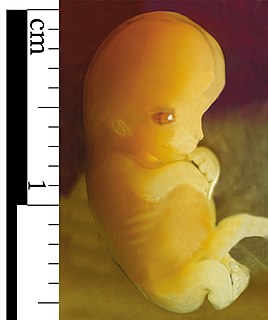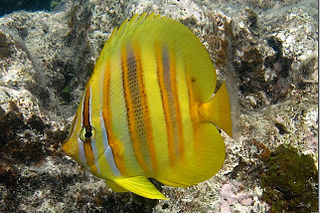
An embryo is an initial stage of development of a multicellular organism. In organisms that reproduce sexually, embryonic development is the part of the life cycle that begins just after fertilization of the female egg cell by the male sperm cell. The resulting fusion of these two cells produces a single-celled zygote that undergoes many cell divisions that produce cells known as blastomeres. The blastomeres are arranged as a solid ball that when reaching a certain size, called a morula, takes in fluid to create a cavity called a blastocoel. The structure is then termed a blastula, or a blastocyst in mammals.

Sharks are a group of elasmobranch fish characterized by a cartilaginous skeleton, five to seven gill slits on the sides of the head, and pectoral fins that are not fused to the head. Modern sharks are classified within the clade Selachimorpha and are the sister group to the rays. However, the term "shark" is also used to refer to extinct shark-like members of the subclass Elasmobranchii, such as hybodonts, that lie outside the modern group.

Convolvulaceae, commonly called the bindweeds or morning glories, is a family of about 60 genera and more than 1,650 species. These species are primarily herbaceous vines, but also include trees, shrubs and herbs. The tubers of several species are edible, the best known of which is the sweet potato.

Tilapia is the common name for nearly a hundred species of cichlid fish from the coelotilapine, coptodonine, heterotilapine, oreochromine, pelmatolapiine, and tilapiine tribes, with the economically most important species placed in the Coptodonini and Oreochromini. Tilapia are mainly freshwater fish inhabiting shallow streams, ponds, rivers, and lakes, and less commonly found living in brackish water. Historically, they have been of major importance in artisanal fishing in Africa, and they are of increasing importance in aquaculture and aquaponics. Tilapia can become a problematic invasive species in new warm-water habitats such as Australia, whether deliberately or accidentally introduced, but generally not in temperate climates due to their inability to survive in cold water.

Plantaginaceae, the plantain family, is a large, diverse family of flowering plants in the order Lamiales that includes common flowers such as snapdragon and foxglove. It is unrelated to the banana-like fruit also called "plantain." In older classifications, Plantaginaceae was the only family of the order Plantaginales, but numerous phylogenetic studies, summarized by the Angiosperm Phylogeny Group, have demonstrated that this taxon should be included within Lamiales.

The Passifloraceae are a family of flowering plants, containing about 750 species classified in around 27 genera.

Nyctaginaceae, the four o'clock family, is a family of around 33 genera and 290 species of flowering plants, widely distributed in tropical and subtropical regions, with a few representatives in temperate regions. The family has a unique fruit type, called an "anthocarp", and many genera have extremely large pollen grains.

Goodeniaceae is a family of flowering plants in the order Asterales. It contains about 404 species in twelve genera. The family is distributed mostly in Australia, except for the genus Scaevola, which is pantropical. Its species are found across most of Australia, being especially common in arid and semi-arid climates.

The eight-banded Butterflyfish, also known as the eightband butterflyfish or eight-striped butterflyfish, is a species of marine ray-finned fish, a butterflyfish belonging to the family Chaetodontidae. It is found in the Indo-Pacific region where it is associated with reefs.

Conus spurius, common name the alphabet cone, is a species of sea snail, a marine gastropod mollusk in the family Conidae, the cone snails and their allies.

Lee Hong Susan Lim, more commonly known as Susan Lim, was a Malaysian parasitologist who specialised on the Monogenea, a class of parasitic flatworms which are important ectoparasites of fishes. She was the first and only Malaysian commissioner elected to the International Commission on Zoological Nomenclature. Her research was mainly in the fields of taxonomy and faunistics, although in later years, she became involved in a wide range of parasitological disciplines.

Chaetodon aureofasciatus, the golden butterflyfish, golden- banded butterflyfish, golden-striped butterflyfish or sunburst butterflyfish, is a species of marine ray-finned fish, a butterflyfish belonging to the family Chaetodontidae. This coral eating species is found on shallow reefs in the western Pacific Ocean.

Chaetodon rainfordi, Rainfords's butterflyfish, also known as the gold-barred butterflyfish or the Northern butterflyfish, is a species of marine ray-finned fish, a butterflyfish, belonging to the family Chaetodontidae. It is found in the southwestern Pacific Ocean where it is associated with coral reefs.
Pseudachorutes is a genus of springtails in the family Neanuridae. There are more than 50 described species in Pseudachorutes.
Mixogaster breviventris is a species of syrphid fly in the family Syrphidae.
Chrysotoxum chinook is a species of syrphid fly in the family Syrphidae.
Aradus funestus is a species of flat bug in the family Aradidae. It is found in North America.
Aradus depictus is a species of flat bug in the family Aradidae. It is found in North America.
Animal Ethics is a nonprofit organization formed to promote discussion and debate around issues in animal ethics and to provide information and resources for animal advocates. They also do outreach work in several countries on the issue of speciesism. Their aim is to create a world where moral consideration is extended to all sentient beings. The organization's website covers topics such as speciesism, sentience, veganism and wild animal suffering and has content translated into several languages.












